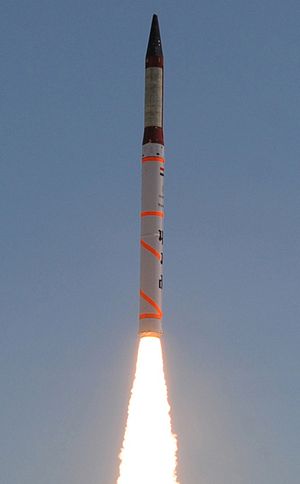As reported by the Hindu yesterday, India completed its fourth trial launch of the Agni-IV ICBM today. The trial was apparently successful; an Agni-IV was launched from a land-based mobile missile launcher on the Indian Army’s test site on Wheeler Island, cruised at an altitude of 600 km before splashing down in the Bay of Bengal after a 3,000 km flight.
All radar stations, telemetry, and electro-optical systems along the east coast monitored the performance of the missile during the entire operation and, according to a Defense Research and Development Organization (DRDO) official, “Flight was successful and it met all the mission parameters.”
According to DRDO, the Agni-IV missile is equipped with 5th generation onboard computer and distributed architecture. It has the latest features to correct and guide itself for in-flight disturbances. Its ring laser gyro-based inertial navigation system is supported by a highly reliable redundant micro navigation system that ensures the vehicle reaches the target within two-digit accuracy. The re-entry heat shield can withstand temperatures in the range of 4,000 degrees centigrade and makes sure the avionics function normally with inside temperature remaining less than 50 degrees centigrade
The Agni-IV is designed to carry a one-tonne nuclear payload over a range of 3,500 km. The Agni missile series represent a crucial component of India’s nuclear strategic deterrence arsenal.
This is not the first time the Agni-IV has been successfully tested. The weapon’s last trial, in 2014, went off without a hitch as well. This test will apparently be the last before the Agni-IV is deployed to active duty.
The Agni-IV is an important part of India’s nuclear second-strike capability. The weapon can be mounted and launched from a mobile land platform, which allows the nukes to disperse in case of heightened tensions with a nuclear-armed neighbor. An interesting aspect of the Agni-IV is its range. At 3,500 km, it is clearly more than sufficient to reach all parts of Pakistan. It is more likely that it is designed as a deterrent against China; 3,500 km would put large parts of the country in range.
The Agni program has previously been plagued by setbacks. Several iterations of the missile, notably the Agni-II and III, have experienced severe technical malfunctions, causing delays and budget overshoots. Now that the Agni-IV is ready for deployment, Delhi has moved one step closer to having a secure “nuclear triad”: a secure second-strike capability, with platforms able to launch nuclear weapons from land, air, and sea.
It remains to be seen when precisely New Delhi will cinch its triad. The next class of Agni ICBMs, the Agni-V, is supposed to be launched from the indigenously developed INS Arihant-class nuclear submarine. Although India already has a submarine-based nuclear-capable cruise missile, the Nirbhay, that has come with serious technical difficulties. Furthermore, the Nirbhay has a range of only 700 km, while the Agni-V will be able to hit targets from up to 10,000 km away, giving India a global nuclear strike capability.

































